Application is a type of fine art. She develops a sense of color, composition, creativity, trains fine motor skills.. Its implementation teaches the skills of working with paper, glue, scissors. When performing a collective application, children learn to work together, which helps to improve relations in the group. Application classes are held in all groups. kindergarten with babies from 5 to 8 years. In each group, conducting classes has its own characteristics.
AT younger group children stick ready fruit from paper. In the middle you can cut the fruits and vegetables themselves. In older children they are introduced to different types of applications and with mosaic and clipping applications. Develop self-fulfillment of still lifes from fruits and vegetables in a basket or on a plate.
In the preparatory group do the work independently, repeat the geometric forms, get acquainted with the subject and other types of applications.
- Children develop cutting skills, learn to properly and safely use scissors.
- They learn compositions, improve their skills in working with paper, glue.
- Develop creative abilities.
- They cultivate diligence, responsibility, ability to complete the work, accuracy.
To work you need to prepare:
- color paper, cardboard for the base;
- scissors, fruit patterns;
- glue: pencil or PVA, then you need to prepare brushes and remind you how to work with them;
- the pencils.
 At the beginning of the class, the educator talks about fruits: how they are useful, how they grow and look. Explains what they will do today recalls the rules for handling scissors and paper. You can recall the mysteries. Then the tutor shows the picture “Vase with Fruit” and explains that today they will make a volumetric application.
At the beginning of the class, the educator talks about fruits: how they are useful, how they grow and look. Explains what they will do today recalls the rules for handling scissors and paper. You can recall the mysteries. Then the tutor shows the picture “Vase with Fruit” and explains that today they will make a volumetric application.
Children in this group already have cutting skills, so the “Fruit Basket” application will not seem difficult for them.
First you need to prepare a pattern of a vase or plate. It should be drawn and cut. For children who find it difficult to do this, the caregiver helps to draw the template, and they cut them out. On a plain cardboard stick a paper basket or plate.
Then proceed to the manufacture of fruit. The yellow paper is folded in half and again in half. Draw a pattern of pear. Since the paper has four layers, cut out 4 fruits.
In the same way we cut out the rest, but for an apple we take pink and yellow paper and cut out 2 apples of each color.
Fold in half each piece. Then glue the sides of the four blanks. Now you need to harmoniously decompose the finished fruit on the vase, stick, open each.
At the end of the lesson, the children view their work, and the teacher of each work gives a rating, as a rule, a positive one. In children, after praise, self-esteem and desire to work further increases.
It is possible to consolidate skills to hold a lesson "Applique vegetables on a plate."
Creating a breakaway application in the older group
- to raise interest in the application;
- to acquaint with performance of application from scraps of paper;
- develop fine motor skills;
- to train carefully, consistently and independently work.
Required materials:
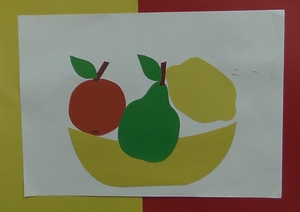
After the introductory conversation, the children begin making the vase. Each child has a template with a vase and fruit. The teacher offers to take purple paper for grapes and pick some small pieces. Then smear the silhouette of the fruit with glue. Pieces of paper are glued neatly and tightly to each other. In the same way fill the rest of the silhouettes.
The tablecloth is smeared with glue and filled with pieces of white thread no larger than 1 cm in size.
With a pencil, children paint on tails and leaves for each fruit. Then from fragments of colored paper make a frame around the edge of a sheet of cardboard with a vase.
As a result, children senior group together with the teacher admire their work.
"Fruit basket" in the preparatory group
Children of this age have the skills to work with the application, because the task is performed independently. They continue to improve their skills and abilities, as well as learn new techniques and develop their creative abilities. Children repeat geometric figures.
What you need to prepare for the lesson:

The teacher explains what the children will do in class. Tells what a still life is, showing cooked illustrative material.
Start with the manufacture of the basket. Brown and yellow paper is cut into stripes. The brown stripes are laid out on the table, the yellow ones are interlaced with brown, creating an imitation of basket weaving. It turns out checkered rug. It is turned over and a basket pattern is applied to the back side, encircled with a pencil and cut out. Stick on cardboard or sheet of thick paper. This process is complicated, some children will need the help of a caregiver..
Children draw fruits and cut them out. Then on these templates cut out and paste fruit in a basket. Glue green tails and leaves. A couple of fruits are stuck near the basket, as if they had fallen out.
You can conduct classes on the following topics: "Basket of vegetables", "Basket of mushrooms". The last lesson is complicated byThat mushrooms consist of two parts of a different color. It is necessary to cut the caps of red or brown color and white or gray legs. Then glue both parts into one mushroom.
The application "Fruits on a plate" is carried out to consolidate the ability to work independently.
In the senior or in the preparatory group can be a lesson "Vase with flowers." Worth pay attention to childrenthat a low wide vase is needed for fruits and vegetables, and a tall beautiful vase for flowers. Thus, it is possible to teach children to cut symmetrical objects from paper folded in half. In this case, cut out half of the template and get the whole after expanding the cut silhouette.
 After that you can cut the flowers. It is necessary to offer children the manufacture of simple flowers: tulips, bells or any other. Children can decide: stick them so that the stems of the flowers are not visible or stick the flowers higher by adding green stems with leaves.
After that you can cut the flowers. It is necessary to offer children the manufacture of simple flowers: tulips, bells or any other. Children can decide: stick them so that the stems of the flowers are not visible or stick the flowers higher by adding green stems with leaves.
In the eldest and preparatory groups You can acquaint children with the creation of fruits and vegetables by crushing napkins of the desired color in the ball. Then glue the balls on a vase, plate, basket. You can spend in these groups of the application of thread. Painted fruits and vegetables on a paper plate are smeared with glue and thick cuttings of threads of corresponding colors are glued onto it.
Features classes in the application in the younger group
Younger children still do not know how to cut. The caretaker cuts various fruits or vegetables, cuts the silhouette of a canning can. Lessons can be held individuallythen each student has a can; with collective application, children stick fruit in a common jar.
Before class, the teacher tells a tale that fruits are needed to bunnies or bear cubs. He reads poems or riddles. Repeats the names and colors of each fruit with children, explains why fruit should be canned.
Then the children get to work and stick ready-made paper fruits on the jar in the way the teacher explained: so that they do not stick out over the edges of the jar and crawl over one another. If the younger child becomes confused and is unable to start work, the caregiver helps.
Then the children admire the work with the teacher. He praises the good work of children, treating them with fruit.
The impact of classes in the application on the development of children's creative abilities
In kindergarten, application classes are held in all groups and become more complex with age. Children learn to cut, work with scissors, paper, glue. They have not only the development of physical skills, but also mental development: they learn how to memorize the names of fruits and vegetables, to distinguish them by their appearance, remember the names of colors, repeat geometric shapes, get basic knowledge of composition and combination of colors.
In these classes for children educated accuracy, the ability to plan your work and bring it to the end. On collective applications, children learn to work together, not to interfere with each other, to help, if necessary, to rejoice in the results of collective work.
At school, appliqué classes continue and children improve their skills acquired in kindergarten. Accuracy, diligence, responsibility for their work are in demand at school for work lessons and even for such serious lessons as mathematics and foreign languages.
These useful personality traits will be needed by children more and more as they get older. Therefore, applications should be treated with due respect..
Attention, only TODAY!
Summer is not only the time of beautiful and bright flowers, but it is also the time of ripening of various useful fruits (fruits, vegetables, seeds, mushrooms). What is their delicious flavor ...
We suggest you make summer application "Gifts of Summer". You can give this application to your mother, you can decorate the interior.
To complete the application, you must prepare:
Colored paper;
Basis for application;
Scissors;
Black felt pen.
Step-by-step application process
1. Preparing templates for making applications

2. Prepare the base for the application. You can take and print just such a base. You can take a piece of cardboard, or paint a base on watercolor paper.

3. Cut out the details (elements) of the application.

For cutting out the elements of the application, we use the method of symmetrical cutting. To do this, fold the paper along the dotted lines and cut out the lobes of pears, leaves, berries, cuttings.
The photo shows the process of cutting the proportion of the fruit of pears, strawberries, leaves.
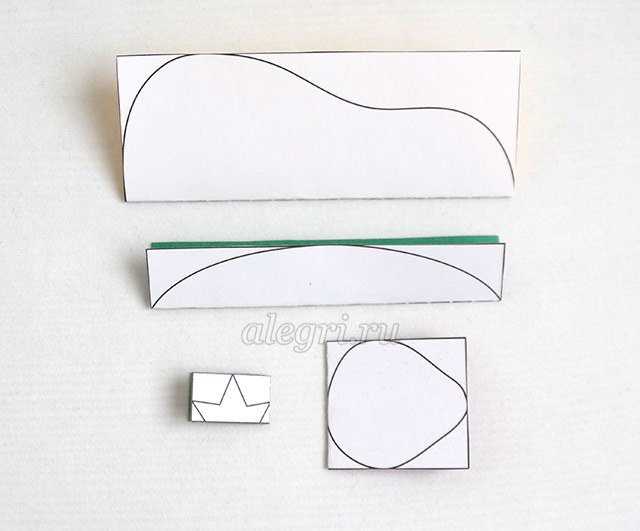
Fold along the dotted lines and cut.
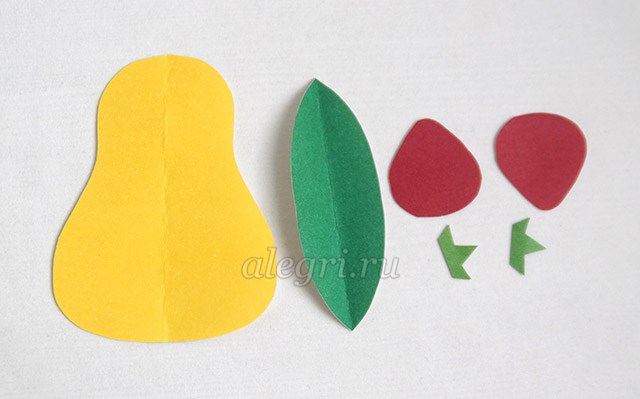
4. Take all the shares of the pear.
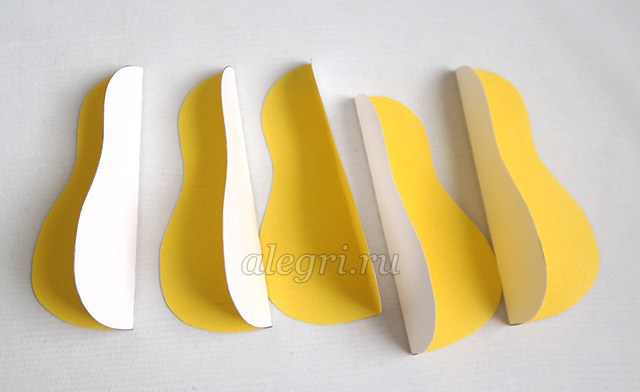
The figure shows the process of gluing the proportion of pear fruit.

Our pear is ready.
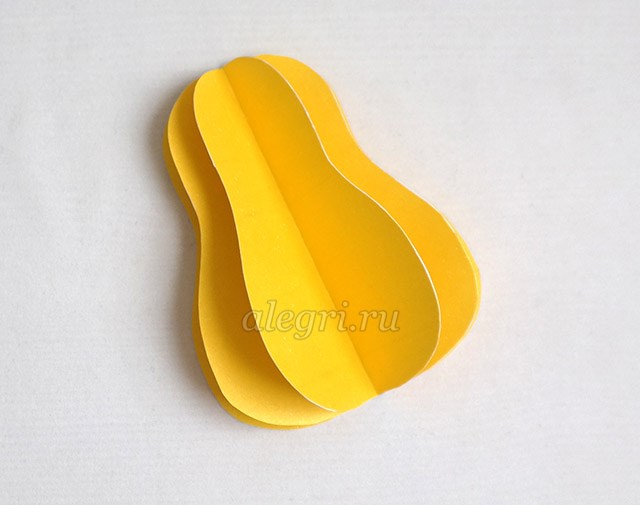
Glue it to the branch.

5. Glue the leaves. We glue only the tips of the leaves.
Here the volume is visible due to the fact that only the tips of the leaves were glued.

6. On the strawberry berries paste pink "sides".

7. Glue the green tails.

8. Glue the strawberries to the base of the application.

9. Draw black dots with black felt-tip pen.

10. Our application is ready.

This is the application we got.

|
Summer application for kindergarten with your own hands Summer is not only a time for beautiful and bright flowers, but it is also the time of ripening of various fruits (fruits, vegetables, seeds). We offer you to make a summer application “Cherry twigs” from the “Gifts of Summer” series. Such an application can be presented to the mother, you can decorate the interior. To complete the application, you must prepare: - colored paper; ... |
|
Summer application for kindergarten with your own hands Summer is not only a time for beautiful and bright flowers, but it is also the time of ripening of various fruits (fruits, vegetables, seeds). We offer you to make a summer application "Corn" from the series "The Gifts of Summer". Such an application can be presented to the mother, you can decorate the interior. To perform the application, you must prepare: ... |
|
Autumn appliqués for kindergarten do-it-yourself Autumn is the time of harvest. In the fall we collect and pumpkins. You can make different healthy and tasty dishes from pumpkin: pancakes, cereals, cookies, etc. We suggest you make an autumn applique “Pumpkin in the garden”. Such an application can be presented to the mother, you can decorate the autumn interior. To perform the application, you must prepare: ... |
Municipal preschool educational institution Kindergarten number 1
"Rainbow" urban district Vlasikha
Abstract
application classes
on the topic: "Vegetables on a plate"
(for older children)
prepared the teacher
Kalmykova Yulia Viktorovna
v. Vlasikha
2016
1. Purpose of the lesson : creation of the application "Vegetables on a plate"
2. Tasks:
Repeat the names of fruits and vegetables
Exercise cut round and oval shapes from squares and rectangles, smoothly cutting corners
Combine elements of the composition in color, size, shape
Develop coordination of movements of both hands.
Fix the ability to neatly paste the image.
3. Type of occupation : occupation - creativity.
4. Form of employment : individual, group.
5. Duration : 20 minutes.
6. Participants: tutor, children of the older group.
7. Age of students: 5-6 years.
8. Equipment and materials:
Vegetable dummies on a tray, plate layout on a rectangular base, colored blanks of square and rectangular shape scissors, glue, glue brush, oilcloth, tray.
9. Preliminary preparation:
10. Methods and techniques for working with children:
Practical: cutting, sticking.
Visual: viewing models of vegetables.
Verbal: solving riddles.
11. Structure of the lesson:
Stage LessonContent
Time
Organizing time.
Communication Arouse interest in the upcoming activities.
3 min.
Main part.
Active learning, consolidation of knowledge and skills.
12 min
Final part.
Reviving emotions.
Analysis of children's work.
Develop speech activity through dialogue and answers to questions.
5 minutes.
12. Course of the lesson
Stagesactivities
The actions of the teacher
Children's activities
Motivational
incentive
He brings a tray with vegetables, lays out vegetables.
Onthe plate is a harvest ,
Whatever you want, choose.
For borscht and for salad.
Mom will be very happy
Children watch with interest the actions of the teacher
Organizational-search
Offers to consider vegetables, asks about their shape, color.
In the garden.
By mysterious laws, incomprehensible until now,
Cucumber grows green, near-red tomato.
Eggplant blue next to the yellow melon.
And the earth is black and black, and the earth is one for all.
Mysteries
Our piglets grew up on the garden,
To the sun sideways, tails crocheted.
These piglets play hide and seek with us.
(Cucumbers)
Thisvery fast vegetable
Solve by the way.
He's cheeky, red, smooth,
It grows on everyone in the garden.
Put it in the sun.
He will ripen at the window,
This fat little lady
A well-known.(A tomato)
Riddles from the garden
The leaves are collected in the heading
In the garden of the villagers.
Without it, not thick in the middle.
What is her name? (Cabbage)
We took her clothes,
Tubs are no longer empty -
They will get fermented ... (cabbage)
The little families live underground,
Water them from the watering can.
Both Polina and Antoshka
Call for digging ... (potato)
Oh, we cry on him
Kohl want to clean.
But from a hundred ailment
The bitter will cure us ... (onions)
He grows up on a bed,
No offense to anyone.
Well, and cry all around
Because they are cleaning ... (onions)
Head and mustache on top.
No, he does not taste sweet.
Come running full speed
We have a tear to dinner ... (garlic)
Like a watermelon -
Also thick-skinned.
For dress yellow accustomed,
Heats up the sun ... (pumpkin)
This vegetable is a pumpkin brother -
Also seemingly thick.
Lay under a leaf on a flank
Between the beds ... (zucchini)
These sturdy guys
In the leaves hiding in the garden.
Twins Twins
Green ... (cucumbers)
Climb on a string
Brothers from the bed-hills.
These are twin brothers,
And their name is ... (cucumbers)
He lived in a greenhouse in the summer,
With the hot sun was friends.
With him fun and enthusiasm.
It is red ... (tomato)
In the summer, without fear of heat,
Mature red balls.
Matured as a selection.
What kind of vegetable? (A tomato)
Have a handsome fat man
Bright red sides.
In a hat with a tail a signor -
Round ripe ... (tomato)
The yellow ball has grown into the ground,
From above only green tail.
Holds the bed tightly
Round vegetable. This is ... (turnip)
Split old house:
There was little space in it.
All tenants are alarmed.
Who are they? (Pea)
Growing on the bed of Christmas trees,
Do not prick their needles.
Deft hidden in the ground
Their spine ... (carrot)
Under the earth grew up
Round and burgundy became.
It was wet in the rain
And hit the soup to us ... (beets)
Invites children to compose a composition on a dish of vegetables - gifts of autumn.
Tells about the methods of cutting vegetables.
Children, and what do we need to make an application? (scissors, white and colored paper, glue). The children know where it is, take the glue by themselves, and find the prepared paper in the same place. Scissors gives tutor when everyone is sitting at the tables, reminding of safety.
What shape does a cucumber look like? (rectangle). What color is it? (green). We take a green rectangle, cut a cucumber, by cutting the corners, as an educator (show). Stick on the "plate".
What shape does a tomato look like? (square). What color is it? (green, not ripe yet, but ripe - red). We take a red square, cut out a tomato, by cutting the corners, as a tutor (show). Stick on the "plate".
During work and the teacher comes up and helps the children, praises for the good work, suggests how to do it.
Consider vegetables, answer questions -
a tomato is like a bowl, a cucumber is like an oval.
Listen to the verses
Children guess
Listen carefully to the teacher.
Independent work.
Cut out vegetables and make up the composition.
Reflexive - corrective
Organizes an exhibition of works.
What we talked about today.
What you have depicted on the application.
To praise for the good work, to love the completed application.
Arrange their work, choose the ones you like.
Expected Result:
Know: geometric shapes, map the image with the kind.
Have: idea of the method of cutting - rounding.
Be able to: cutting a ball - a tomato; oval - cucumber;
References
1. Zimin A.N. Theory and methods of musical education of children preschool age. - M .: TC Sphere, 2010.
2. Zvereva OL, Krotova T.V., Ganicheva A.N.Family pedagogy and home education of children of early and preschool age. - M .: TC "Sphere", 2009.
3. Kapranova V.A. History of Pedagogy. - M .: Academy, 2005.
4. Kutsakova L.V.Design and manual labor in kindergarten. - M .: Mosaic-Synthesis, 2008.
5. Komarova TS “Classes for visual activity in the kindergarten preparatory group. ” Mosaic-Synthesis. 2011
6. The program of education and training in kindergarten, edited by M.A. Vasilyeva, V.V. The stamp, TS.Komarova. - 3rd ed., Corr. and add. - M. Mosaic - Synthesis. 2005
7. Shvayko G.S. “Lesson on the visual activity in kindergarten. Preparatory school group: Program, notes. Handbook for teachers preschool institutions". M. Humanitarian ed. center VLADOS. 2000